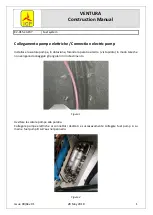
DOCUMENT NUMBER:
L500-912.820 ISSUE JUL 20, 2016
AMENDMENT: 00
DATE: --
CHAPTER-
PAGE 3-13
MAINTENANCE MANUAL STEMME S12
3.4.3
COOLING SYSTEM
SYSTEM DESCRIPTION
Refer to »Maintenance Manual (Heavy Maintenance) for ROTAX Engine Types ROTAX 912 and 914
Series«, section 75.
Engine is cooled by liquid cooled cylinder heads, ram air cooled cylinders and by cooling the oil.
LIQUID COOLING
The radiator for the coolant is installed on the LH side of the fuselage frame, supplied by ram air
from the LH cowl flap. The refill container is installed on the forward left side of the upper fire
wall. A thin tube links the relief valve in the refill container with the overflow container, which is
installed in the LH landing gear bay. The quantity of the coolant can be checked at the scale on
the overflow container and must be between min and max markings.
The coolant lines consist of flexible coolant hoses and aluminum tubes.
RAM AIR CYLINDER COOLING
Ram air for cylinder cooling is guided from the RH cowl flap through a duct to a distribution
plenum on the engine upper side. The distributor is made of special heat-resistant GFRP.
INLET COWL FLAPS
Oil cooler, radiator, inter-cooler, ram air cylinder cooling and the carburetors are supplied with
ram air from the LH and RH cowl flaps in the lateral engine cowlings. To avoid low engine tem-
peratures during high cruising speeds or descents from high altitudes, the cowl flap aperture
can be reduced with a handle on the instrument panel. During T/O, climb and at high OAT´s, the
cowl flaps should be fully open. Five reduced apertures can be set for different conditions. It is
not possible to close the cowl flaps completely as long as the nose-cone is open. The cowl flap
control is linked to the nose-cone operation: closing of the nose-cone also closes the cowl flaps
and opening of the nose-cone opens the cowl flaps to the position set by the cowl flap handle.
OUTLET COWL FLAP
The warmed air streams exit the engine compartment via the lower outlet cowl flap. The aperture
of the outlet cowl flap, like the inlet cowl flaps, is controlled by the nose-cone operation as well as
by the cowl flap handle on the instrument panel. The shape of the small fuselage fairing behind
the outlet cowl flap maintains a slot when the cowl flap is closed with the nose-cone, to allow a
permanent ventilation of the engine compartment.
Summary of Contents for S12
Page 1: ......
Page 3: ......
Page 97: ......
Page 238: ......
Page 240: ......
Page 242: ......
Page 244: ......
Page 246: ......
Page 248: ......
Page 250: ......
Page 255: ...A FLIGHT CONTROLS PITCH CONTROL AND TRIM ...
Page 256: ......
Page 257: ...B FLIGHT CONTROLS LATERAL CONTROL WING FLAP AILERON ...
Page 258: ......
Page 259: ...C FLIGHT CONTROLS AIRBRAKE CONTROL ...
Page 260: ......
Page 261: ...D FLIGHT CONTROLS RUDDER CONTROL ...
Page 262: ......
Page 263: ......
Page 264: ......
Page 265: ...E PROPULSION SYSTEM ...
Page 266: ......
Page 268: ......
Page 270: ......
Page 272: ......
Page 274: ......
Page 276: ......
Page 278: ......
Page 280: ......
Page 282: ......
Page 284: ......
Page 286: ......
Page 288: ......
Page 290: ......












































